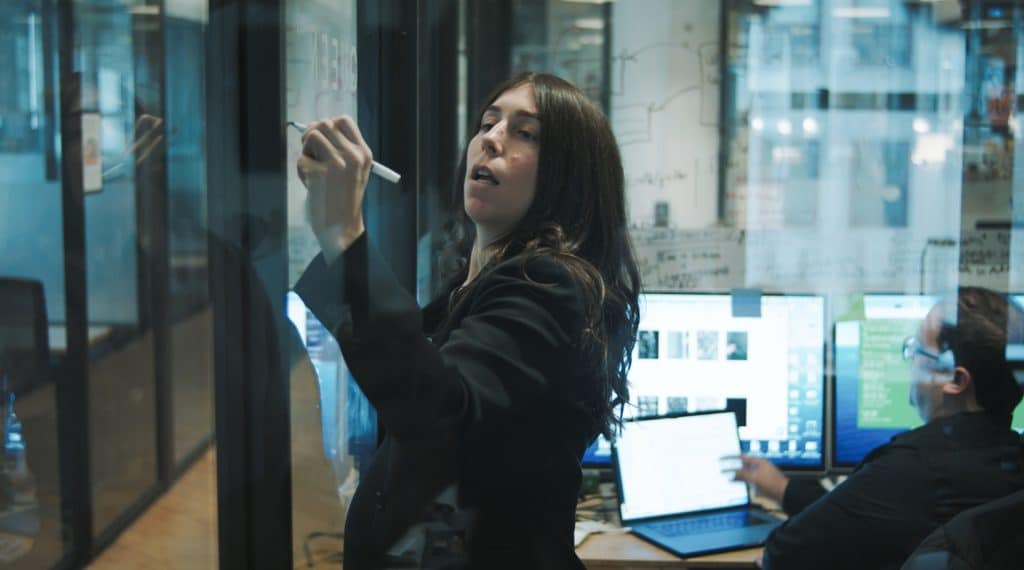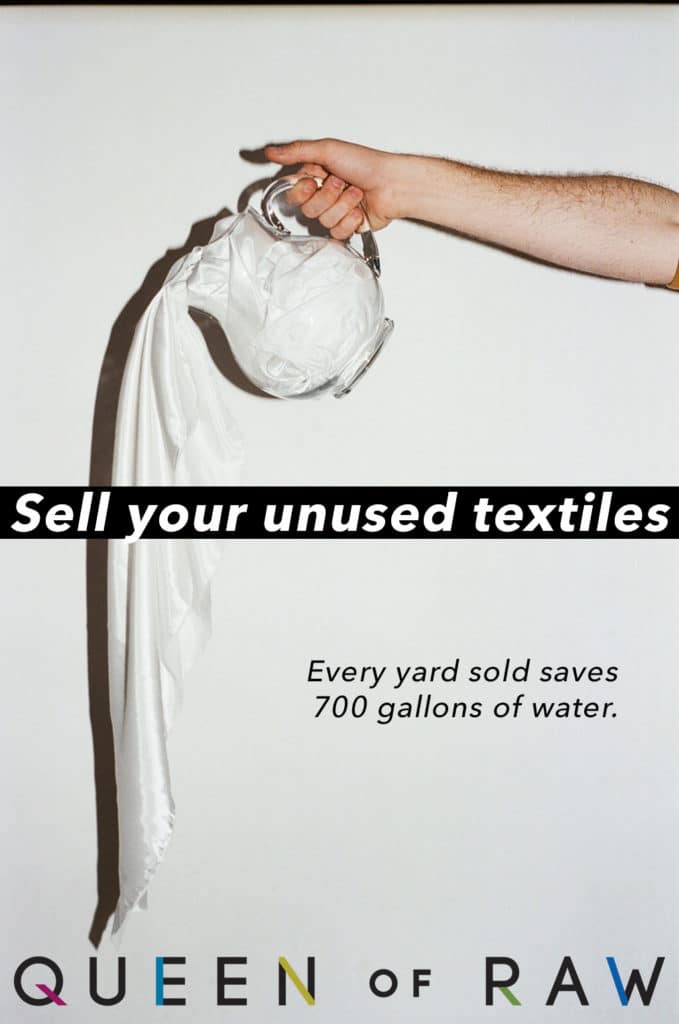 Stephanie Benedetto has repurposed fabric in her blood. At the end of the 19th century, her great grandfather started finding unused textiles and turning them into clothes. A hundred years later, Stephanie has taken the same idea and run with it. In 2018, she launched Queen of Raw – an online marketplace that uses blockchain technology to connect over 175,000 people and companies who want to buy and/or sell unused fabric stock.
Stephanie Benedetto has repurposed fabric in her blood. At the end of the 19th century, her great grandfather started finding unused textiles and turning them into clothes. A hundred years later, Stephanie has taken the same idea and run with it. In 2018, she launched Queen of Raw – an online marketplace that uses blockchain technology to connect over 175,000 people and companies who want to buy and/or sell unused fabric stock.
In doing so, Stephanie is helping to minimise the huge environmental burden of creating new fabric. Every yard of fabric purchased on Queen of Raw saves a whopping 700 gallons of water – as well as the chemical pollutants and greenhouse gases typically pumped out to make the threads, yarns and fabrics that our clothes are made of. All while keeping fabric out of landfill – which, in a world where a garbage truck full of textiles goes to landfill every second, is a solution that is needed more urgently than ever.
Even for companies keen to sell off their deadstock and improve their sustainability, knowing exactly how much unused fabric there is in their supply chain and where it is is no small challenge. To help, Stephanie has now launched MateriaMX (short for Material Exchange) – a technology platform that helps companies map, measure and trace waste in their supply chain in real time. Then, with a click, any unused material the system identifies can be added to the Queen of Raw marketplace – all while tracking the water, toxins, energy and money that is being saved.
Looking ahead, Stephanie estimates that by 2025, Queen of Raw can save over 4 billion gallons of water and 2 million pounds of chemicals – and keep 2 million tonnes of textiles out of landfill.

Stephanie on how pollution can be turned into profit, the role of technology in a less wasteful future, and why sustainability is a story that needs to be told.

Queen of Raw was the first name I ever thought of. My family has always called me the queen, and I want to empower everyone around the world to feel like the kings and queens of their domain, so that they can make a difference. And ‘raw’ for raw materials – rather than the word sustainable, which means so many things to so many people.
Fixing fashion means rebuilding fashion supply chains to support people, planet, and profit. This includes evaluating every step from farm to finished good to end of life.
It’s so positive to see that these issues are becoming top priorities for businesses. Waste, sustainability, unused inventory, digital supply chains – a few years ago, these weren’t top of mind. But now businesses see the value – that this isn’t a nice to have, it’s a have to have. They see how it can help them to survive today and thrive tomorrow.
It has served us really well to lead with the economics. Doing good is absolutely critical, but you can’t expect for-profit businesses to do good just for doing good’s sake. If we can build innovative new business models and solutions that unlock massive profitability, and it happens to also do well for people and planet, that’s the win win win – how do you say no to that? Creating future sustainable solutions that lead with profitability – that is how you get the biggest stakeholders in the world on board. And that is how we’re going to get widespread adoption and solve issues like the world’s water crisis.
Then, once businesses have freed up cash, they can put it into other ways to make their business more sustainable. They can find other areas of their supply chain to improve, to do better for people and planet.
 It’s interesting to look back at 2008, and talk about what we’re going through right now. I was on Wall Street as a corporate attorney and in 2008, of course, the market crashed. It got very dark – talk about seeing the height of waste and greed and excess. I took it as my opportunity to reevaluate what I was doing and how I could best serve society and the future. Now, again, we’re in this period of downturn and uncertainty and in some ways, darkness. How can we find the light, and build opportunity and new business models and new visions of the future?
It’s interesting to look back at 2008, and talk about what we’re going through right now. I was on Wall Street as a corporate attorney and in 2008, of course, the market crashed. It got very dark – talk about seeing the height of waste and greed and excess. I took it as my opportunity to reevaluate what I was doing and how I could best serve society and the future. Now, again, we’re in this period of downturn and uncertainty and in some ways, darkness. How can we find the light, and build opportunity and new business models and new visions of the future?
Post COVID, I can see things moving towards more on demand, readily available, localised supply chains and digital supply chains. Digital solutions are key to making this happen.
Now that the world has slowed down a little bit, businesses have an opportunity to get up to date. The fashion industry is incredibly behind in technology – some are still using pen and paper and Excel spreadsheets to manage things. Some had still been doing things the way my great grandfather did in the 1890s. And that’s why we have all these wastes and challenges. This slowing down means they can digitise – which will have huge implications for people, planet and profit.

But I wouldn’t be an effective leader if I put technology first. Technology delivers the solution, but it isn’t the solution itself. We saw a business problem, and found a way to solve it. I could describe what we do without talking about technology – it’s just the way we get to the solution.
The future of fashion is a world with no clothes – at least not clothes in the traditional sense. Imagine being able to fly around the world with no suitcase. After arriving at your destination, you find all your clothes 3D printed in your closet to your exact specification and style. When your travels are over, leave everything behind to be broken down into raw materials and then redistributed to the next person. That is the future of fashion and a world with no waste!
As we grow, we’re learning about new parts of the problem that we could solve. We’re hearing time and time again that for large businesses, there aren’t any solutions for unused inventory of finished goods. For example, 100,000 white t shirts that are sitting in a warehouse waiting to be burned or landfilled because that company’s business plan changed or they shifted to a new style or colour. Could our technology apply? This is an untapped opportunity, and a problem we’re really interested in solving.
Social media is creating a real opportunity for sustainability in fashion. As much as there are challenges in the fast paced nature of social media and needing a new outfit for Instagram every day, it also makes all of us the world’s gatekeepers. Whenever there’s a bad practice right now, the world knows and remembers, and they know it instantly – because we are all on our social media conversing about these issues. We’re still getting there in terms of what the most sustainable social media digitally could look like and how we can bring quality, trust, transparency, traceability and sustainability to the media itself. But the volume of information, the access and the connectivity cannot be undone, and that’s beautiful for sustainability.
Telling the sustainability story to the end consumer is key. People, especially younger people, want to buy better. They want to make educated, informed decisions. So we want to help businesses tell this story. We’re looking at how we can connect our platform to a QR code that would appear on finished clothing – so that when you go and buy that shirt, you can scan the hang tag and know if it’s certified Queen of Raw deadstock, and exactly how many gallons of water and pounds of chemicals you’ve saved.
To have diversity evolve in fashion in a meaningful way, we can’t have organisations just publish statistics and hire people to check a box. Companies need to engage in meaningful conversations around these issues to see how they can have a lasting impact on their businesses.
There’s a huge opportunity for emerging independent designers to adopt these principles. For a large fashion brand or retailer, it’s very hard to change an old school way of doing things. Which means that for new designers, it’s a huge competitive advantage. They can iterate quickly, they can move fast, they can adopt these new solutions, and then be the next player in the market to really dominate. It’s such an exciting time.
My future power would be… to heal. To protect people, especially future generations, and to heal the earth. Healing can change everything. I hope in my way I can start to not just be a band aid, but to heal some of the damage we’ve done.

AtlasAction: Hear more from Stephanie on her podcast. And get shopping for some queenly fabrics from as little as 3 yards.
Do you know someone helping to rethink our relationship with fashion? Submit a project to FashionFutures and we’ll put them in the spotlight. Stephanie Benedetto was talking to Becca Warner, a writer for Atlas of the Future.

